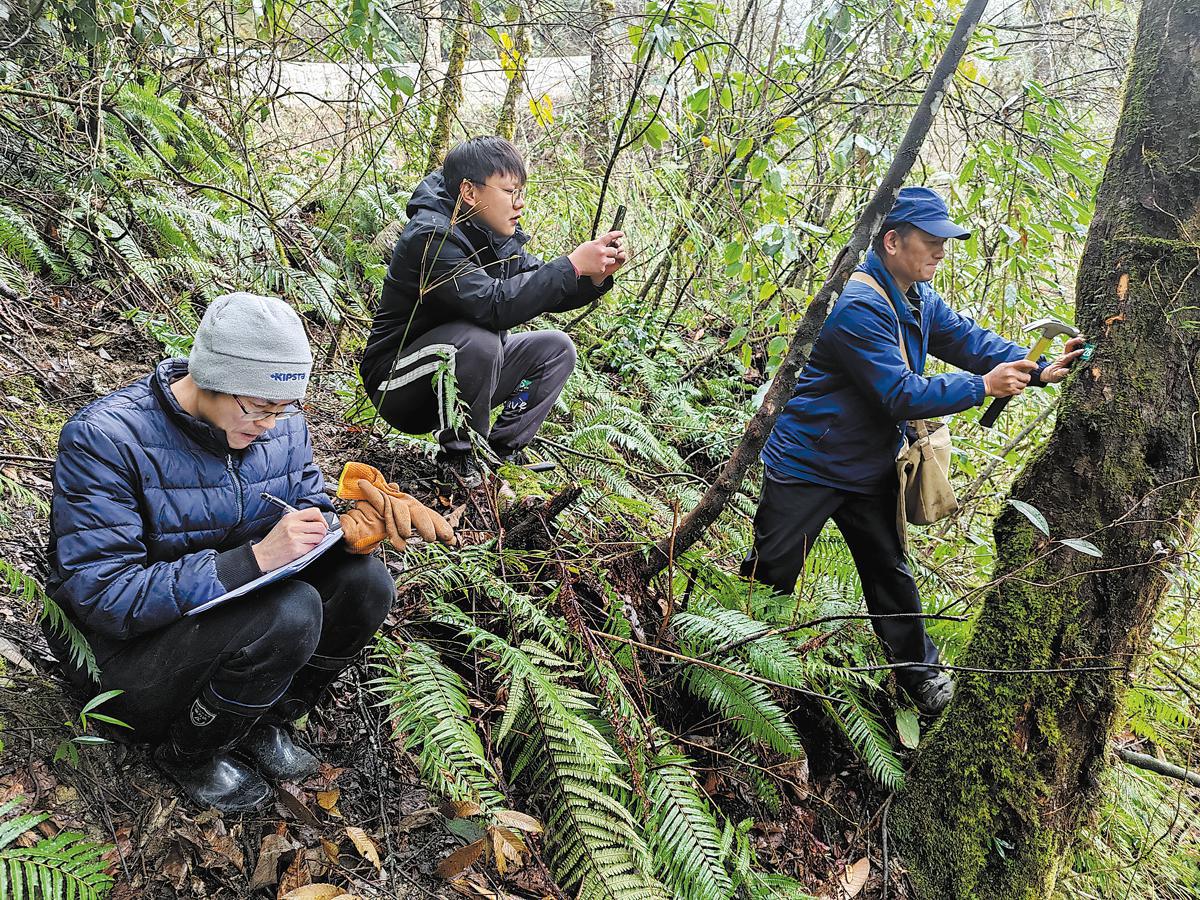Preserving Yunnan's rare wild plant species
Conservation in province's biodiverse backyard helps secure future for evergreen Rhododendron vialii

Editor's note: As protection of the planet's flora, fauna and resources becomes increasingly important, China Daily is publishing a series of stories to illustrate the country's commitment to safeguarding the natural world.

While not as iconic as the rose or as fragrant as the honeysuckle, the loss of Rhododendron vialii would be significant for many.
The evergreen shrub is classified as vulnerable by the International Union for Conservation of Nature due to only a few thousand surviving in the wild. Rhododendron vialii are mainly found in Southwest China and parts of Laos and Vietnam.
Chang Yuhang, a staff member at Kunming Botanical Garden in Southwest China's Yunnan province, said Rhododendron vialii, despite their small number, have a high ornamental value and breeding potential. The plant features a tubular corolla, bright red petals and comes into bloom during Spring Festival.
The species, which once numbered fewer than 1,000 in the wild, has had its population boosted tenfold over the past four years, said Chang, who added that Yunnan has been steadfast in its commitment to safeguarding "wild plant species with extremely small populations", a crucial component of China's broader biodiversity conservation initiatives.
"According to specimens and literature records from about a century ago, Rhododendron vialii was once widely distributed across the subtropical monsoon evergreen broadleaved forests and semi-humid evergreen broad-leaved forests of Yunnan," Chang said.
"However, human activities such as agricultural reclamation and road construction have led to habitat fragmentation, affecting seed dispersal and gene flow, resulting in difficulties in natural regeneration and a decrease in genetic diversity," he said.
He added that, thriving at altitudes ranging from 1,000 to 2,000 meters, the ecological adaptability of the species could be expanded for ornamental purposes such as landscaping and potted cultivation. However, this potential is overshadowed by the increasing threat of illegal deflowering.
A survey in 2021 found that the species was on the brink, with just four populations surviving in China, located in Pu'er, Yuxi and Honghe in central and southern Yunnan.
Recognizing the severity of the situation, the province included Rhododendron vialii in Yunnan province's Conservation and Rescue Plan for Plant Species with Extremely Small Populations (2021-30) for priority and urgent research and conservation. This designation was reinforced when the species was listed in the Provincial Key Protected Wild Plants of Yunnan (2023), reflecting both its ecological vulnerability and urgent need for conservation.

Conservation efforts have yielded critical breakthroughs, including the assembly of the plant's chromosome-level genome, making it the first haplotype-resolved genome reported in the Rhododendron genus. This is an important genome resource, and might help to reveal more about the evolutionary history of Rhododendron vialii species, as well as provide a basis for conservation genomics and molecular breeding, Chang said.
Comprehensive field studies have revealed that there are 21 main wild populations of Rhododendron vialii. While the largest population contains around 5,000 individuals — comprising both juveniles and mature plants, marginal and isolated populations are found in Guizhou province and the Guangxi Zhuang autonomous region. Some populations contain as few as three individuals.
Conservation genomics have been able to reveal the genetic diversity, population structure, demographic history and mutation load of Rhododendron vialii. By integrating ecological modeling and population adaptability simulations, conservation strategies were proposed. Moreover, in situ and ex situ conservation measures, as well as reintroduction efforts, have been steadily advanced, Chang said.
Despite these advancements, Sun Weibang, director and a principal investigator at the Yunnan Key Laboratory for the Integrative Conservation of Plant Species with Extremely Small Populations from the Kunming Institute of Botany of the Chinese Academy of Sciences, cautioned against premature optimism. He said that while current conservation measures have effectively prevented immediate extinction, the species continues to face threats from habitat fragmentation and uneven population distribution.
"China's national conservation strategy prioritizes species with fewer than 5,000 mature individuals in total and fewer than 500 mature individuals in each isolated population, and those with fewer than 1,000 or even 100 mature individuals are given the highest priority, as defined in the concept of plant species with extremely small populations," Sun said.
He highlighted that the critical unknown factor remains the ratio of juveniles to mature individuals across populations, and an accurate assessment of their long-term viability is not available without more precise age-structure data.
Sun attributed China's pioneering role in introducing the concept of plant species with extremely small populations in 2005 to Yunnan's exceptional biodiversity.
"Despite comprising only 4 percent of China's total land area, Yunnan harbors nearly half of the nation's higher plant species. However, rapid economic development in this historically underdeveloped province has resulted in significant anthropogenic pressures on native flora," he said.
In terms of conserving these plants with extremely small wild populations, Sun emphasized the need to focus on addressing human-induced threats.
Conservation measures for species with extremely small populations include field investigations documenting individual and population-level traits; establishing in situ conservation sites; in situ or near situ conservation focused on protected areas and ecological corridors; ex situ conservation through living plant cultivations in botanical gardens; seed banking; in vitro preservation; population reinforcement; reintroduction programs; and citizen science initiatives.

"These methods, however, may not be sufficient or suitable for every species, for example, when common propagation techniques are not adequate," Sun said. He added the need for tailored techniques for the effective protection of each species or even each population within the same species.
Yang Yuming, a professor at the Yunnan Academy of Forestry and Grassland, highlighted the significant progress in plant conservation initiatives in recent years.
He pointed out that the current category of plant species with extremely small populations, which started in 2022, has expanded to include 79 new species, totaling 101 species, compared to the 2010 edition. A total of 40 species have been removed from the list due to notable success in conservation measures and population recoveries. These include Malania oleifera, or garlic-fruit tree, which is under second-class State protection and listed as vulnerable by the International Union for Conservation of Nature.
"Malania oleifera is a unique species endemic to China, having survived during the Quaternary glaciations some 2.6 million years ago. As an ancient species, it plays an extremely important role in the study of the evolution of the Earth's life system, thereby possessing high conservation status and scientific research value," Yang said.
By the late 20th century, Malania oleifera's economic and medicinal potential was recognized. Scientists discovered nervonic acid in its seed oil — a compound essential for preventing age-related neurological disorders, including memory loss, Alzheimer's and Parkinson's diseases, yet unable to be synthesized by humans. Historically sourced from shark liver oil, Malania oleifera seeds provide the richest plant-based supply of nervonic acid at around 25 percent, far exceeding vertebrate brains such as shark brain tissue, which contains only 5 percent, Yang said.
Given its multifaceted value and a declining population due to illegal harvesting and habitat fragmentation, Malania oleifera was listed among China's first batch of plant species with extremely small populations.

"We've implemented rapid artificial propagation techniques for Malania oleifera, including grafting, cutting and genome-assisted cultivation, driving exponential population growth. Currently, Yunnan cultivates over 16,000 hectares of the species, totaling 3 million plants," Yang said. "However, reintroduction attempts at a Guangxi site, which shares a similar altitude, climate and humidity with its native habitat, have encountered obstacles. Our hypothesis points to the absence of specific symbiotic microbes critical for its survival."
National regulations permit the commercial and edible use of second-generation artificially propagated plants. However, this should be conducted under strict scientific supervision, he said.
Yang attributed the project's success to effective public outreach, which has mobilized active participation from local villagers. Dried Malania oleifera nuts now fetch up to 400 yuan ($56) per kilogram in the local market, creating tangible economic benefits.
"While Malania oleifera is a unique case, it provides a replicable model for conserving plant species with extremely small populations," he said. "The hidden potential of various species transforms conservation from a mere scientific obligation to a commitment to preserving global biodiversity heritage."
Contact the writers at limenghan@chinadaily.com.cn





































